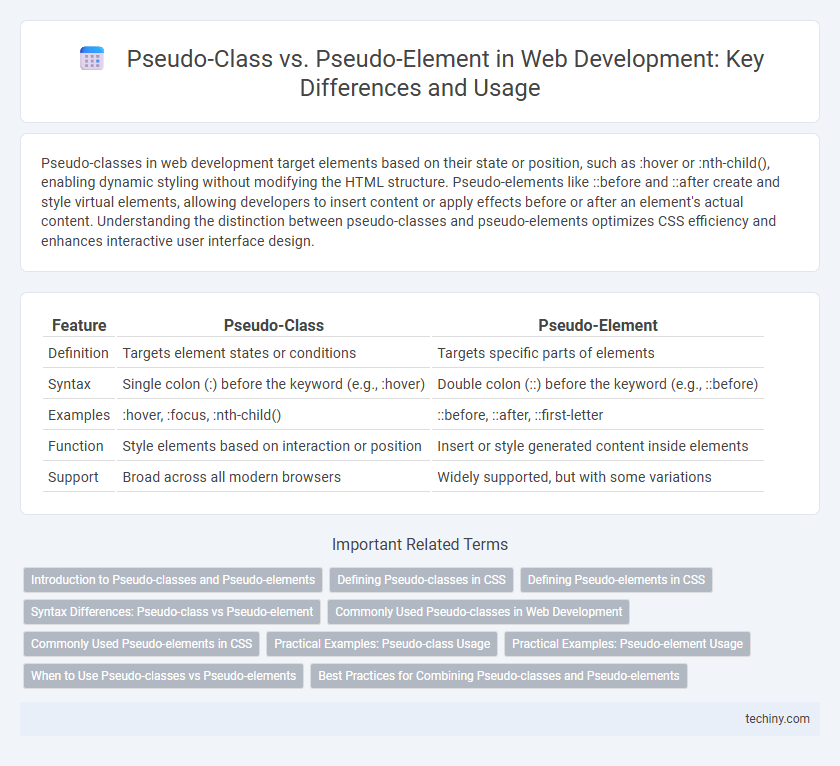Pseudo-classes in web development target elements based on their state or position, such as :hover or :nth-child(), enabling dynamic styling without modifying the HTML structure. Pseudo-elements like ::before and ::after create and style virtual elements, allowing developers to insert content or apply effects before or after an element's actual content. Understanding the distinction between pseudo-classes and pseudo-elements optimizes CSS efficiency and enhances interactive user interface design.
Table of Comparison
| Feature | Pseudo-Class | Pseudo-Element |
|---|---|---|
| Definition | Targets element states or conditions | Targets specific parts of elements |
| Syntax | Single colon (:) before the keyword (e.g., :hover) | Double colon (::) before the keyword (e.g., ::before) |
| Examples | :hover, :focus, :nth-child() | ::before, ::after, ::first-letter |
| Function | Style elements based on interaction or position | Insert or style generated content inside elements |
| Support | Broad across all modern browsers | Widely supported, but with some variations |
Introduction to Pseudo-classes and Pseudo-elements
Pseudo-classes in CSS target elements based on their state or position, such as :hover or :nth-child, enhancing interactivity without adding extra markup. Pseudo-elements like ::before and ::after enable styling of specific parts of elements by creating virtual elements for inserting content or applying effects. Both features improve web design flexibility by allowing precise styling control beyond standard selectors.
Defining Pseudo-classes in CSS
Pseudo-classes in CSS define a specific state of an element, such as :hover, :focus, or :nth-child(), allowing developers to apply styles dynamically based on user interaction or document structure. Unlike pseudo-elements, which target portions of an element like ::before or ::after, pseudo-classes do not create new elements but modify existing ones based on conditions. Defining pseudo-classes enhances web development by enabling more precise and interactive styling without additional HTML markup.
Defining Pseudo-elements in CSS
Pseudo-elements in CSS are used to style specific parts of an element, such as ::before and ::after, by injecting content without altering the HTML structure. They enable designers to create effects like inserting decorative icons or styling the first letter or line of a block of text, enhancing visual presentation. Unlike pseudo-classes that target element states, pseudo-elements represent virtual elements within the DOM for precise content and style control.
Syntax Differences: Pseudo-class vs Pseudo-element
Pseudo-classes use a single colon (:) syntax, such as :hover or :focus, to target elements in a specific state, while pseudo-elements use a double colon (::) syntax, like ::before or ::after, to style specific parts of an element. CSS3 introduced the double colon syntax for pseudo-elements to differentiate them from pseudo-classes, enhancing code clarity and maintainability. Understanding these syntax differences is crucial for precise styling in modern web development practices.
Commonly Used Pseudo-classes in Web Development
Commonly used pseudo-classes in web development include :hover, :focus, :active, :nth-child(), and :visited, which enhance user interaction and styling without additional JavaScript. The :hover pseudo-class modifies element styles when a user points to it, improving navigation and UI feedback. Unlike pseudo-elements that target specific parts of an element (such as ::before or ::after), pseudo-classes apply styles based on the element's state or structural position.
Commonly Used Pseudo-elements in CSS
Commonly used pseudo-elements in CSS include ::before and ::after, which enable developers to insert content before or after an element's actual content without modifying the HTML structure. The ::first-letter pseudo-element targets the first letter of a block of text, allowing for advanced typography effects, while ::first-line applies styles to the first line of a text block, enhancing readability and design precision. These pseudo-elements are essential for creating complex visual effects and improving user interface design in modern web development.
Practical Examples: Pseudo-class Usage
Pseudo-classes like :hover and :focus enable interactive styling by targeting elements during specific user actions or states without altering the HTML structure. For example, the :hover pseudo-class changes a button's color when a user places a cursor over it, enhancing UX dynamically. In contrast, pseudo-elements create virtual elements such as ::before or ::after to insert decorative content, but pseudo-classes focus primarily on conditional styling based on element state.
Practical Examples: Pseudo-element Usage
Pseudo-elements such as ::before and ::after allow web developers to insert content or style parts of an element without altering the HTML structure, enhancing design flexibility. For example, ::before can add decorative icons before text, while ::after can create custom tooltips or clearfixes to handle floated elements. Utilizing pseudo-elements effectively improves page aesthetics and maintains clean, semantic markup in web development projects.
When to Use Pseudo-classes vs Pseudo-elements
Pseudo-classes are used to define a special state of an element, such as :hover for mouse hover effects or :nth-child() to target specific children in a list, ideal for dynamic user interactions and conditional styling. Pseudo-elements, like ::before and ::after, create virtual elements within the DOM to insert content or style parts of an element without modifying the HTML structure, perfect for adding cosmetic embellishments or complex formatting. Use pseudo-classes when targeting element states and pseudo-elements when needing to style or insert content inside an element.
Best Practices for Combining Pseudo-classes and Pseudo-elements
When combining pseudo-classes and pseudo-elements in web development, always place the pseudo-class before the pseudo-element in the selector to ensure proper specificity and functionality, such as using a:hover::before instead of a::before:hover. Limit the use of multiple pseudo-classes in a single selector to maintain readability and optimize CSS performance, focusing on the most impactful states like :hover, :focus, and :active. Testing combined selectors across different browsers ensures consistent rendering and aligns with best practices for responsive and accessible design.
pseudo-class vs pseudo-element Infographic

 techiny.com
techiny.com